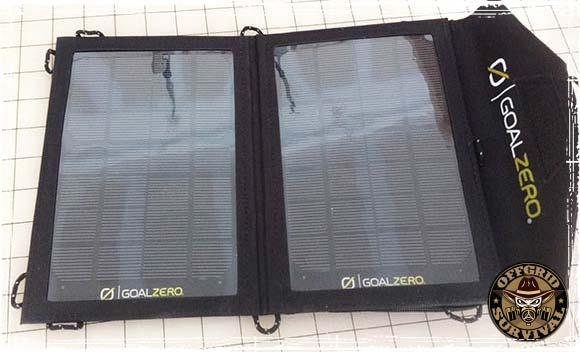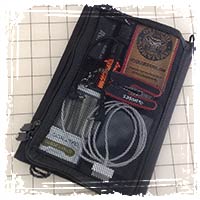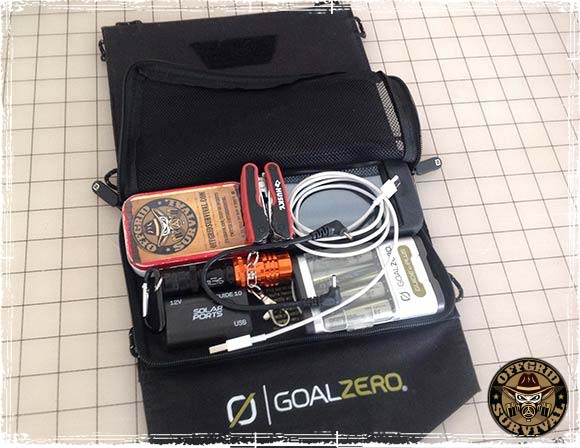Like it or not, electronic devices have become a part of everyday life; and while I love to get away from the trappings of modern-day society, I have to admit, I often take at least one electronic device into the backcountry. In my opinion, some of these devices can be valuable survival tools and shouldn’t be overlooked when hiking in the backcountry, or when preparing for an emergency.
But what happens to those devices when they run low on power? If you’re in the backcountry, or if you’re faced with some sort of disaster where the electric grid has gone down, do you have a way to keep your electronic devices going?
Enter the GoalZero Guide 10 Adventure Kit
Goal Zero Guide 10 Adventure Kit is a small portable solar panel kit that can keep just about any USB powered device going indefinitely, without ever having to rely on the power grid.

How it works:
The Adventure Kit comes with the GoalZero Nomad 7, a small folding two panel solar charger, which can be used in combination with the Goal Zero Guide 10 battery pack. The Panel can be used to directly power a USB powered device, or to charge the Guide 10 power pack.
In testing, I found the Nomad panel could fully charge the Guide 10 battery pack – which has 4 AA Batteries – in about 4 – 6 hours. The rate at which it charged depends on how much direct sunlight the panels receive. Once the batteries in the charger were full, I was able to then use the power pack to charge my iPhone in about 3 hours.
I was able to charge the iPhone directly from the panel, but because of the circuitry in the iPhone this was actually a bit of a challenge. Whenever it got cloudy, the iPhone would stop charging and I then had to unplug, and then replug the USB cord to get it going again. This problem is specific to the iPhone and something that I’ve found with just about every panel I’ve ever tried it with.
The Good:
- The Battery Pack: The Guide 10 comes with a set of four rechargeable AA batteries (and a charger) which can be plugged directly into Nomad 7 Solar Panel. Since there are so many devices that can be powered by AA batteries, this makes it one of its top selling points.
- The Car/Cigarette Adapter: With the addition of the car/cigarette adapter, the Guide 10 Plus Adventure Kit adds functionality that most other chargers don’t have. This was a major plus, when using older devices that may not have a USB power port. For instance, it allowed me to charge my SPOT Global Sat Phone – something that none of my other kits could do.
- Reliability: Out of all the panel/charger kits we’ve tried, this one was one of the most reliable and well made kits on the market.
- Lightweight & Compact: As someone who doesn’t like to add a lot of unnecessary weight to my pack, I was extremely pleased with how lightweight and compact this kit was.
The Bad:
- Can’t charge an iPad, and I had some issues charging an iPhone directly from the solar panel (again, I think this is more of an issue with the iPhone, and it can be resolved by charging directly from the battery pack).
The Ultimate Survival Accessory for Those that Need Power
 What I really liked about this panel, and I know it might sound weird at first, was something that a lot of other companies forgot to add, and that’s the pocket. While this may seem trivial, I found the pocket turns this panel into the ultimate survival accessory for those who like to travel with electronic devices.
What I really liked about this panel, and I know it might sound weird at first, was something that a lot of other companies forgot to add, and that’s the pocket. While this may seem trivial, I found the pocket turns this panel into the ultimate survival accessory for those who like to travel with electronic devices.
If you’re looking for a great everyday carry kit, or something to carry in the backcountry, you might want to take a look at buying one of these panels. I can fit just about everything I want in an EDC in the back pocket, plus I give myself the ability to power my devices indefinitely.

What fits in my GoalZero Adventure Kit?
- The Guide 10Battery Charger: The charger can be used to charge devices or to charge 4 AA Rechargeable Batteries.
- Smart Phone: Which can be used as a communication device, a GPS, and it can be filled with Survival books, backcountry maps and PDF’s.
- Altoids Survival Tin: The Tin is filled with a pocket knife, matches, some emergency medical supplies, fishing gear and some other survival necessities.
- Flashlight: The flashlight takes AA batteries; so the charger can also keep my flashlight going forever.
- A Small Multitool
- Various USB Cords: Cords depend on what devices I have.



Hi
I have recently sent off for the ‘Goal Zero’ which I got at a great price from ebay at $99 AUD, I’m looking forward to testing it out.
I must stress that people should be aware of what rechargeable batteries you should use for your your devices !
I learned the hard way and initially purchased cheap ones from China, these are next to useless as when fully charged they run down within an hour.
I suggest that you should always use ‘Low Self Discharge’ (LSD) batteries, these when fully charged do not run down so quickly and can hold their charge for weeks on end, the best ones to get are ‘Sanyo XX Eneloop’, these are quite expensive, it cost me $22.88 AUD for 4 X AAs, but at least you have the assurance that they will not let you down.
Remember; don’t skimp on cheap batteries as you could be in a life or death situation and reliable power can be your savior !!
Keith
there is one thing you must remember with rechargeable battery’s after sum time they hold less and less of a full charge to the point they wont hold any charge at all. but it is still a good way to save money.
If you haven’t already done so, I suggest getting a second Guide 10, so that you can charge one set of batteries while using the other set.
The key part of the Goal Zero product is the Nomad 7 Solar Panel (you can buy it separately), which can charge USB devices using solar power at the lowest weight. Any backpacker loves more pockets, so they look for lots of pockets. To be real, you really only need so many pockets. So this is an easy equation backpackers need to make for themselves based on their needs. Be a good buyer and get the most value for your hard earned cash. Some will find the Goal Zero Guide 10 as the most appropriate product, others the Nomad 7, and others the Ultimate Survival Accessory. There are other competing products on the market. It comes down to weight, size, watts and connectors (i.e. USB and AAA battery). One product does not fit everyone’s needs.
Please forgive my ignorance but… if the grid goes down what use will our phones be? I understand you would be able to access maps, books and documents saved to your phone. But what else? Surely not communication.
Nancy,
When/If ‘the grid goes down’, cell phones will have little, if any, use beyond paper-weights. Over 80% of the ‘cell towers’ lack any battery backup. i.e., It will be a long time before they come back on-line. The systems that do have battery backup, those in ‘important/high priority’ areas, will generally not function very well since those sites will depend on network access to get a call through or internet access. And if there is no complete circuit into the network/s, you ain’t gonna get Domino’s.
And, depending on how/why the ‘grid went down’, your cell phone might be down also. Along with everything else that uses transistors to work.
The general intent, I think, of this article is to suggest that a bit of concern and interest should be focused into the area of using solar panels and rechargeable batteries. Not a bad idea, but using ‘certain’ brands will weigh heavily on your budget. I personally build my own chargers and buy solar panels individually. Check out instructables dot com for some good ideas.
Batteries are a very different subject. From my experience, Lithium Ion batteries, which include Lithium Cobalt, Lithium Manganese, Lithium Iron, Lithium Nickle cobalt, and Lithium Titanate all do well at first. Then degrade to not much better than Nickle Metal hydride and/or Nickle Cadmium. Until the Nickle/Iron (NiFe) batteries come down in price, we’re all stuck with whatever is on sale. (Notice that there’s a lot of Nickle used in batteries? Hmmmm.)
The best suggestion I have, (IMHO), is to get a multi-battery-type charger. That way you’re covered on whatever battery you buy. Then get a solar panel, build a ‘charge controller’, and get yourself charged up for free.
HAM radio and CB radio does not need a network to function. With the proper equipment communications will not be a problem One will need decent lighting that going to require more than a pocket solar charger. Getting a couple of commercial grade solar panels, deep cycle batteries and associated wiring and controls is a must. Do not get the cheap “solar kits from Harbor Freight, EBay etc. as they a typically cheap Chinese crap and WILL fail. Get your equipment from a solar installer or supply house and set it up as an”off-grid” system. The grid-tie systems are great when the grid is working but become boat anchors as soon as the grid goes down (UL 1741 requirement) Get 12 volt LED lighting, use Rig Runners from http://www.westmountainradio.com for general portable and vehicle DC power distribution. As for portable batteries use Lithium Iron Phospate batteries, they are lightweight at 1/3 the weight of lead-acid prices are reasonable perform rather well, have good charge tolerance and are safe to use. They are sold online, in battery stores and motorcycle shops as they are getting very popular with the sport bike riders. Again, avoid anything that is coming from the Harbor Freights and Ebay discount retailers and anything similar. JW Speaker sells good quality LED vehicle lighting products that are mostly for off-road, farm and construction vehicles and are very bright and come in handy in a survival situation.
A phone is very useful even if the ‘grid goes down’ because they are also a flashlight/flashing light, pedometer(helpful if lost), heart rate monitor (depending on phone), camera (believe me it can be useful), calculator, calender, mp3 player (it can get lonely out there…), ruler, gyroscope, voice recorder, notepad, and probably a few dozen other things that I can’t think of atm which would be great for a survival situation! So unlike what one person said, no, it is not a paperweight simply because there is no service for facebook.
Don’t forget offline maps/GPS that don’t require a data connection. Android has an offline version of SAS survival guide that’s cheap. Any number of other books can be stored for reference including plant identification etc. Most can also be used as a compass. My phone is used more as a tablet then a phone. I would definitely want it with me, whether there’s cell coverage or not.
your forgetting one (the most) important use of a cellphone or tablet… YOU CAN DOWNLOAD PORN!!!